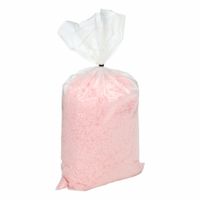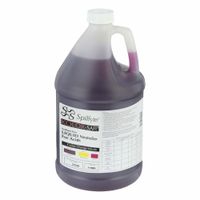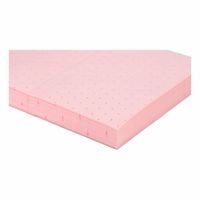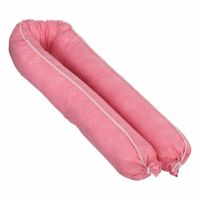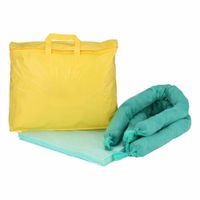Call +(254) 703 030 000 / 751 483 999 / 721 704 777
- Home
- Safety
- Sorbents Spill Control Spill Containment
- Sorbents Spill Kits
- Harsh Chemical Sorbents Spill Kits
.....Read More
Frequently Asked Questions
What are harsh chemical sorbents and spill kits used for?
Harsh chemical sorbents and spill kits are essential tools used for managing and mitigating chemical spills, particularly those involving aggressive or hazardous substances.
Harsh chemical sorbents are materials specifically designed to absorb and contain spills of aggressive chemicals, such as acids, bases, and other corrosive substances. These sorbents are made from materials that are chemically resistant and can effectively neutralize or contain the spill without degrading. They come in various forms, including pads, rolls, pillows, and loose particulate, allowing for flexibility in addressing different spill scenarios. The primary function of these sorbents is to quickly absorb the spilled chemical, preventing it from spreading and causing further damage or contamination.
Spill kits, on the other hand, are comprehensive packages that include all necessary tools and materials to effectively respond to a chemical spill. A typical spill kit for harsh chemicals contains sorbents, personal protective equipment (PPE) such as gloves and goggles, disposal bags, and sometimes neutralizing agents. These kits are strategically placed in areas where chemical spills are likely to occur, such as laboratories, manufacturing plants, and storage facilities. The purpose of a spill kit is to provide a rapid and organized response to a spill, minimizing the risk to personnel, property, and the environment.
Together, harsh chemical sorbents and spill kits are crucial for ensuring safety and compliance with environmental regulations. They enable quick containment and cleanup of hazardous spills, reducing the potential for injury, environmental harm, and costly downtime. Proper training in the use of these tools is essential for effective spill response and management.
How do harsh chemical sorbents work?
Harsh chemical sorbents work by utilizing their chemical properties to absorb or adsorb unwanted substances, typically in the context of spill response or pollution control. These sorbents are designed to interact with specific chemicals, often hazardous or toxic, to mitigate their impact on the environment or human health.
The mechanism of action for harsh chemical sorbents can be categorized into absorption and adsorption. Absorption involves the uptake of a substance into the internal structure of the sorbent material, effectively trapping the chemical within its matrix. This process is akin to a sponge soaking up water, where the absorbed substance is distributed throughout the sorbent's volume.
Adsorption, on the other hand, involves the adherence of molecules onto the surface of the sorbent. This is typically achieved through physical forces such as van der Waals forces or chemical bonds, depending on the nature of the sorbent and the substance being targeted. Adsorption is often surface-specific, meaning the effectiveness of the sorbent is related to its surface area and the chemical affinity between the sorbent and the substance.
Harsh chemical sorbents are often made from materials that have been chemically treated or engineered to enhance their interaction with specific chemicals. For example, activated carbon is a common sorbent that has been treated to increase its surface area and porosity, making it highly effective for adsorbing organic compounds and certain gases.
In practice, these sorbents are deployed in various forms, such as pads, booms, or loose particulates, depending on the nature and location of the spill. Their effectiveness is influenced by factors such as the chemical properties of the spill, environmental conditions, and the physical characteristics of the sorbent itself.
What types of chemicals can harsh chemical sorbents absorb?
Harsh chemical sorbents are designed to absorb a wide range of aggressive and hazardous chemicals. These sorbents are typically used in industrial settings where spills of dangerous substances can occur. The types of chemicals they can absorb include:
1. **Acids**: Sorbents can absorb strong acids such as sulfuric acid, hydrochloric acid, nitric acid, and phosphoric acid. These are commonly used in manufacturing and processing industries.
2. **Bases (Alkalis)**: They can also absorb strong bases like sodium hydroxide, potassium hydroxide, and ammonia solutions, which are often found in cleaning agents and industrial processes.
3. **Organic Solvents**: Harsh chemical sorbents can absorb a variety of organic solvents, including acetone, benzene, toluene, and xylene. These solvents are frequently used in paint thinners, degreasers, and chemical synthesis.
4. **Oxidizers**: Sorbents can handle oxidizing agents such as hydrogen peroxide and sodium hypochlorite, which are used in bleaching and disinfection processes.
5. **Corrosive Chemicals**: They are effective against corrosive chemicals that can cause severe damage to materials and tissues, including certain metal salts and halogens like chlorine and bromine.
6. **Toxic Chemicals**: Sorbents can absorb toxic chemicals that pose health risks, such as cyanides and certain pesticides.
7. **Reactive Chemicals**: They can also absorb reactive chemicals that may pose explosion or fire hazards, including certain peroxides and hydrides.
These sorbents are typically made from materials that are chemically resistant and have high absorbency rates, such as polypropylene, activated carbon, or specialized polymer blends. They are designed to quickly contain and neutralize spills, minimizing environmental and health risks.
What is included in a harsh chemical spill kit?
A harsh chemical spill kit typically includes the following components:
1. **Personal Protective Equipment (PPE):**
- Chemical-resistant gloves
- Safety goggles or face shield
- Chemical-resistant apron or coveralls
- Respirator or mask suitable for the chemicals involved
2. **Absorbents:**
- Absorbent pads or mats
- Absorbent socks or booms to contain the spill
- Loose absorbent materials like vermiculite or clay
3. **Neutralizers:**
- Specific neutralizing agents for acids or bases, depending on the chemicals handled
4. **Containment Tools:**
- Spill containment berms or dikes
- Drain covers or seals to prevent chemicals from entering drainage systems
5. **Cleaning Tools:**
- Brushes and brooms
- Dustpan or scoop
- Disposal bags or containers for contaminated materials
6. **Signage and Labels:**
- Warning signs to alert others of the spill
- Labels for waste containers
7. **Instruction Manual:**
- Detailed instructions for spill response procedures
- Emergency contact information
8. **First Aid Supplies:**
- Basic first aid kit
- Eye wash solution or station
9. **Communication Tools:**
- Two-way radio or phone for emergency communication
10. **Documentation Materials:**
- Incident report forms
- Pen and clipboard
These components are designed to ensure safety, contain and clean up the spill effectively, and comply with regulatory requirements.
How do you use harsh chemical sorbent pads and rolls?
Harsh chemical sorbent pads and rolls are used to absorb and contain hazardous chemical spills. To use them effectively, follow these steps:
1. **Identify the Spill**: Determine the type and extent of the chemical spill to ensure the sorbent material is compatible with the chemical.
2. **Safety Precautions**: Wear appropriate personal protective equipment (PPE) such as gloves, goggles, and protective clothing to prevent exposure to harmful chemicals.
3. **Contain the Spill**: Use the sorbent pads or rolls to encircle the spill, preventing it from spreading. Place them around the perimeter of the spill area.
4. **Absorb the Spill**: Lay the sorbent pads directly on the spill. For larger spills, unroll the sorbent rolls over the affected area. Allow the material to absorb the liquid fully.
5. **Monitor Absorption**: Check the saturation level of the sorbent material. Replace pads or rolls as needed until the spill is completely absorbed.
6. **Disposal**: Once the spill is absorbed, carefully collect the used sorbent materials. Dispose of them according to local regulations for hazardous waste, as they may contain harmful chemicals.
7. **Decontamination**: Clean the affected area with appropriate cleaning agents to remove any residue. Ensure the area is safe for normal operations.
8. **Documentation**: Record the incident, including the type of chemical, amount spilled, and the response actions taken, for future reference and compliance with safety regulations.
9. **Restock Supplies**: Replenish your stock of sorbent pads and rolls to be prepared for future incidents.
By following these steps, you can effectively manage chemical spills using harsh chemical sorbent pads and rolls, ensuring safety and compliance with environmental regulations.
What is the difference between sorbent socks, booms, and pillows?
Sorbent socks, booms, and pillows are all tools used for spill containment and cleanup, but they differ in design, application, and capacity.
Sorbent Socks: These are flexible, tube-like absorbents filled with materials that can absorb liquids. They are typically used to contain and control the spread of spills by surrounding the spill area or wrapping around machinery. Their flexibility allows them to conform to uneven surfaces, making them ideal for preventing spills from spreading into larger areas.
Sorbent Booms: Booms are larger, cylindrical absorbents designed for use in water bodies. They float on the surface and are used to contain and absorb oil spills on water. Booms are connected end-to-end to form a barrier that prevents the spread of oil, making them essential for marine spill response. They have a higher capacity and are more robust than socks, suitable for large-scale spill containment.
Sorbent Pillows: These are flat, cushion-like absorbents used for absorbing larger volumes of liquid in confined spaces. They are ideal for placing under leaks or drips, in sumps, or in areas where a concentrated absorption is needed. Pillows can hold a significant amount of liquid relative to their size and are often used in industrial settings for localized spill management.
In summary, the primary differences lie in their shape, application, and capacity: socks are flexible and used for containment on land, booms are large and used for waterborne spills, and pillows are compact and used for absorbing spills in confined spaces.
How do harsh chemical neutralizers make spills safe to clean?
Harsh chemical neutralizers make spills safe to clean by altering the chemical properties of the spilled substance, thereby reducing its hazardous nature. When a chemical spill occurs, it can pose risks such as toxicity, flammability, or corrosiveness. Neutralizers work by engaging in a chemical reaction with the spill, transforming it into a less harmful substance.
For acidic spills, neutralizers typically contain basic compounds like sodium bicarbonate or calcium carbonate. These bases react with the acid to form water and a salt, effectively reducing the acidity and corrosiveness of the spill. Conversely, for alkaline spills, acidic neutralizers such as citric acid or vinegar are used to lower the pH, converting the spill into a safer form.
In addition to pH adjustment, some neutralizers contain absorbent materials that help contain the spill, preventing it from spreading and making it easier to clean up. These absorbents can be in the form of powders or granules that soak up the liquid, allowing for easy removal.
Furthermore, certain neutralizers are formulated with indicators that change color to signal when neutralization is complete, ensuring that the spill is safe to handle. This visual cue is crucial for confirming that the hazardous properties have been effectively mitigated.
Overall, the use of harsh chemical neutralizers is a critical step in spill response, as it minimizes the immediate dangers posed by the spill, protects the environment, and ensures the safety of personnel involved in the cleanup process.
